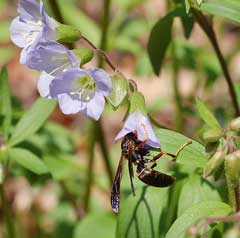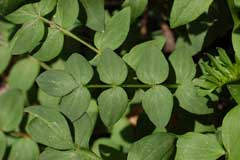 |
|
http://en.wikipedia.org/wiki/User:Ram-Man |
 |
| http://en.wikipedia.org/wiki/User:Ram-Man |
Translate this page:
Summary
Physical Characteristics

 Polemonium reptans is a PERENNIAL growing to 0.3 m (1ft) by 0.4 m (1ft 4in).
Polemonium reptans is a PERENNIAL growing to 0.3 m (1ft) by 0.4 m (1ft 4in).
See above for USDA hardiness. It is hardy to UK zone 4. It is in flower from April to May. The species is hermaphrodite (has both male and female organs) and is pollinated by Bees.
Suitable for: light (sandy) and medium (loamy) soils and prefers well-drained soil. Suitable pH: mildly acid, neutral and basic (mildly alkaline) soils. It can grow in semi-shade (light woodland) or no shade. It prefers moist soil.
UK Hardiness Map
US Hardiness Map
Synonyms
P. humile. Salisb.
Plant Habitats
Woodland Garden Sunny Edge; Dappled Shade; Shady Edge;
Edible Uses
References More on Edible Uses
Medicinal Uses
Plants For A Future can not take any responsibility for any adverse effects from the use of plants. Always seek advice from a professional before using a plant medicinally.
Alterative Astringent Diaphoretic Expectorant Pectoral
The dried roots have a slightly bitter and acrid taste[4]. They are alterative, astringent, diaphoretic, expectorant and pectoral[4, 61, 222, 238]. They can be used in an infusion with water or as a tincture with alcohol[4]. They are used internally in the treatment of coughs, colds, bronchitis, laryngitis, tuberculosis, feverish and inflammatory diseases, including skin conditions and poisonous bites[238]. The root is rarely used in modern herbalism[238]. It is harvested in the autumn and dried for later use[238].
References More on Medicinal Uses
The Bookshop: Edible Plant Books
Our Latest books on Perennial Plants For Food Forests and Permaculture Gardens in paperback or digital formats.

Edible Tropical Plants
Food Forest Plants for Hotter Conditions: 250+ Plants For Tropical Food Forests & Permaculture Gardens.
More

Edible Temperate Plants
Plants for Your Food Forest: 500 Plants for Temperate Food Forests & Permaculture Gardens.
More

More Books
PFAF have eight books available in paperback and digital formats. Browse the shop for more information.
Shop Now
Other Uses
Hair
A decoction of the whole plant is used as a hair rinse[213].
Special Uses
References More on Other Uses
Cultivation details
Prefers a moist well-drained fertile soil in sun or semi-shade[200]. Plants are best grown in a soil approaching that of a moraine and they must not be allowed to dry out in the summer[1]. Plants are hardy to about -20°c[187]. A number of named varieties have been selected for their ornamental value[187]. Plants have a creeping root and can multiply very quickly[4]. They can also self-sow to the point of nuisance[200]. The plants have a smell that attracts cats. The cats roll in the plants with evident pleasure and can cause considerable damage to young plants and ones that have recently been moved[238, K].
References Carbon Farming Information and Carbon Sequestration Information
Temperature Converter
Type a value in the Celsius field to convert the value to Fahrenheit:
Fahrenheit:
The PFAF Bookshop
Plants For A Future have a number of books available in paperback and digital form. Book titles include Edible Plants, Edible Perennials, Edible Trees,Edible Shrubs, Woodland Gardening, and Temperate Food Forest Plants. Our new book is Food Forest Plants For Hotter Conditions (Tropical and Sub-Tropical).
Shop Now
Plant Propagation
Seed - sow spring in a cold frame[14]. When they are large enough to handle, prick the seedlings out into individual pots and grow them on in the greenhouse for their first winter. Plant them out into their permanent positions in late spring or early summer, after the last expected frosts. Division in early spring or early autumn[111]. Larger divisions can be planted out direct into their permanent positions. We have found that it is better to pot up the smaller divisions and grow them on in light shade in a cold frame until they are well established before planting them out in late spring or early summer.
Other Names
If available other names are mentioned here
Native Range
NORTHERN AMERICA: United States (Connecticut, Indiana, Massachusetts, Michigan (south), New Hampshire, New Jersey, New York, Ohio, Pennsylvania, Rhode Island, Vermont, West Virginia, Illinois, Iowa, Kansas, Minnesota (southeast), Missouri, Oklahoma, South Dakota, Wisconsin (south), Alabama, Arkansas, Delaware, Georgia, Kentucky, Maryland, Mississippi, North Carolina, Tennessee, Virginia)
Weed Potential
Right plant wrong place. We are currently updating this section.
Please note that a plant may be invasive in one area but may not in your area so it's worth checking.
Conservation Status
IUCN Red List of Threatened Plants Status :

Growth: S = slow M = medium F = fast. Soil: L = light (sandy) M = medium H = heavy (clay). pH: A = acid N = neutral B = basic (alkaline). Shade: F = full shade S = semi-shade N = no shade. Moisture: D = dry M = Moist We = wet Wa = water.
Now available:
Food Forest Plants for Mediterranean Conditions
350+ Perennial Plants For Mediterranean and Drier Food Forests and Permaculture Gardens.
[Paperback and eBook]
This is the third in Plants For A Future's series of plant guides for food forests tailored to
specific climate zones. Following volumes on temperate and tropical ecosystems, this book focuses
on species suited to Mediterranean conditions—regions with hot, dry summers and cool, wet winters,
often facing the added challenge of climate change.
Read More
Expert comment
Author
L.
Botanical References
43200
Links / References
For a list of references used on this page please go here
Readers comment
© 2010, Plants For A Future. Plants For A Future is a charitable company limited by guarantee, registered in England and Wales. Charity No. 1057719, Company No. 3204567.